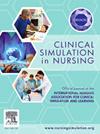Exploring extended immersive simulation-based education to prepare undergraduate nursing students for professional practice: A scoping review
IF 2.5
3区 医学
Q1 NURSING
引用次数: 0
Abstract
Background
Extended immersive simulation (EIS), a subset of simulation-based education (SBE), provides prolonged simulation experiences that replicate real-world professional practice. While extensive research exists on SBE, no scoping reviews have mapped EIS-based education's impact on undergraduate nursing education.
Aim
To investigate the literature on EIS related to undergraduates' learning experiences and engagement. It evaluates teaching modalities and learner-centred approaches in EIS, exploring their impact on student engagement and learning outcomes.
Method
Following the Joanna Briggs Institute framework, this review analysed 684 publications from PubMed and ProQuest (2012-2024). Two authors independently screened titles, abstracts, and full texts, using detailed analysis and thematic categorisation.
Results
Fifteen papers met the criteria. Thematic analysis revealed three themes: Student-Centred Learning Approaches, Structure of EIS, and Simulation Outcomes in nursing programs.
Conclusion
EIS and student-centred approaches improve nursing students' learning and readiness. Despite limited literature, EIS boosts engagement and prepares students in a controlled environment. More research is needed on student support, facilitator training, and academic guidance. Combining EIS with traditional methods is recommended for optimal development.
探索扩展沉浸式模拟教育为护理本科学生的专业实践做准备:范围综述
扩展沉浸式模拟(EIS)是基于模拟的教育(SBE)的一个子集,它提供了复制现实世界专业实践的长时间模拟体验。虽然有广泛的研究存在于SBE,但没有范围审查映射了基于is的教育对本科护理教育的影响。目的探讨环境影响评价与大学生学习经历和敬业度的相关文献。它评估了环境影响信息系统的教学模式和以学生为中心的方法,探讨了它们对学生参与和学习成果的影响。方法遵循Joanna Briggs研究所的框架,本综述分析了PubMed和ProQuest(2012-2024)的684篇出版物。两位作者独立筛选标题,摘要和全文,使用详细的分析和专题分类。结果15篇论文符合标准。专题分析揭示了三个主题:以学生为中心的学习方法、EIS的结构和护理课程的模拟结果。结论eis和以学生为中心的方法提高了护生的学习和准备水平。尽管文献有限,但EIS提高了学生的参与度,并为他们在受控环境中做好了准备。需要在学生支持、辅导员培训和学术指导方面进行更多的研究。建议将环境影响评价与传统方法相结合,以实现最佳开发。
本文章由计算机程序翻译,如有差异,请以英文原文为准。
求助全文
约1分钟内获得全文
求助全文
来源期刊

Clinical Simulation in Nursing
NURSING-
CiteScore
5.50
自引率
15.40%
发文量
107
期刊介绍:
Clinical Simulation in Nursing is an international, peer reviewed journal published online monthly. Clinical Simulation in Nursing is the official journal of the International Nursing Association for Clinical Simulation & Learning (INACSL) and reflects its mission to advance the science of healthcare simulation.
We will review and accept articles from other health provider disciplines, if they are determined to be of interest to our readership. The journal accepts manuscripts meeting one or more of the following criteria:
Research articles and literature reviews (e.g. systematic, scoping, umbrella, integrative, etc.) about simulation
Innovative teaching/learning strategies using simulation
Articles updating guidelines, regulations, and legislative policies that impact simulation
Leadership for simulation
Simulation operations
Clinical and academic uses of simulation.
 求助内容:
求助内容: 应助结果提醒方式:
应助结果提醒方式:


